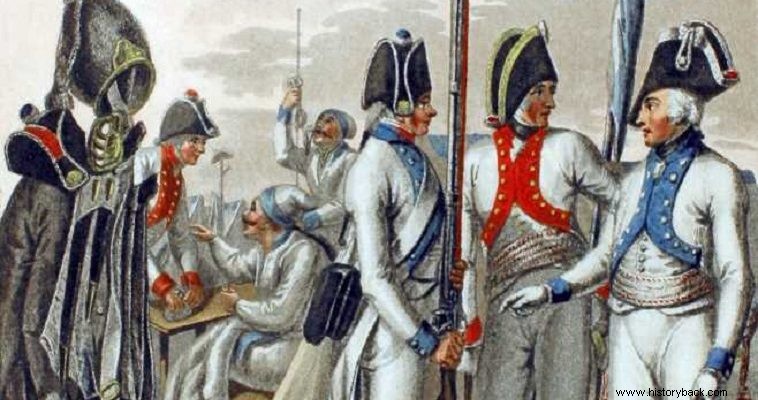
Saxony is one of the oldest German states. Having come under the influence of Prussia after the Seven Years' War, it continued to fight on its side until the disastrous battle of Jena (1806), after which it was forced to side with Napoleon.
The Saxon Army had one of the best cavalry corps in Europe. The Saxon infantry, however, was not so famous for its quality. Although the live material was good to excellent however the problem centered on the top leadership of the army and the quality of the infantry officer corps.
The infantry was organized into regiments of the two battalions. Each battalion fielded four companies of musketeers and one company of grenadiers, each 150 strong. The grenadier companies were detached from their organic battalions and every four formed ad hoc grenadier battalions.
Each regiment had a strength of 1,753 men. It was commanded by a colonel with his small staff. Each battalion was commanded by a major and each company by a captain assisted by a lieutenant.
Altogether the regiment had one colonel, two majors, 10 captains, 12 lieutenants, eight second lieutenants, 30 sergeants, 80 corporals, 20 flutists, 30 drummers, 20 pioneers, 12 doctors, one camp officer, one military justice officer, three staff officers of the colonel, 300 grenadiers and 1,200 musketeers. The best shooters of each company formed a group of snipers, "hunters", according to the terminology of the time.
The infantry wore a white shirt and collar with the distinctive colors of each regiment on the cuffs and lapels of the shirt. The musketeers wore a black double-breasted hat, while the grenadiers wore a characteristic tall fur hat. They also wore black breeches and high black knee-high boots.
Non-commissioned officers and soldiers carried a leather, white-colored, outfit on which hung the black wooden cartridge case with a capacity of 60 cartridges. Non-commissioned officers carried pistols, while musketeers and grenadiers carried a 1.50 m Prussian-style musket and a 45 cm bayonet.
All carried a small sword, while non-commissioned officers also carried a lance and sickle and the characteristic rod with which they punished soldiers. Officers generally wore the same uniform. However, they wore a larger double-breasted, silver-colored cloth belt and, depending on their rank, high riding boots or gaiters.
The junior officers of the grenadiers carried muskets like their men . The other officers, up to the rank of lieutenant, also carried a lance and a sword. The superiors carried only a sword.
The infantry was trained according to the Prussian system. He fought in line formation three fathoms deep, unleashing continuous volleys at the opponent, against whom he charged with the bayonet as soon as he showed signs of yielding. Against opposing cavalry, the infantry formed a square. Saxon foot soldiers were not trained to fight in a phalanx attack formation.
The main weakness of the Saxon infantry was the mental distance between the basically noble officers and the non-commissioned officers and soldiers. The result of this was that the infantry was adequate, professional, one might say, in battle, but lacking the spark that could make it heroic.
Nevertheless, in the battle of Jena where the Saxon infantry participated, they fought well. The Winkel grenadier battalion even won the admiration of even these Frenchmen by managing to escape fighting in a square formation, although it was constantly attacked by both the French cavalry and the light infantry.
After Jena, Saxony came under the influence of France. Nevertheless, its army continued to be organized and fight in the same way until 1810 when it was reorganized according to the French model. The Saxon foot soldiers took part in the continuation of the campaign against Prussia and Russia, in 1807 and on June 14 they fought in the Battle of Friedland against the Russians.
In 1809, during the war against Austria the Saxons fought under the command of the French marshal Berdadot. At the famous battle of Bagram they fought well, relative to their training, with the infantry suffering 50% casualties. However, their sacrifice was never recognized by the arrogant Napoleon.
